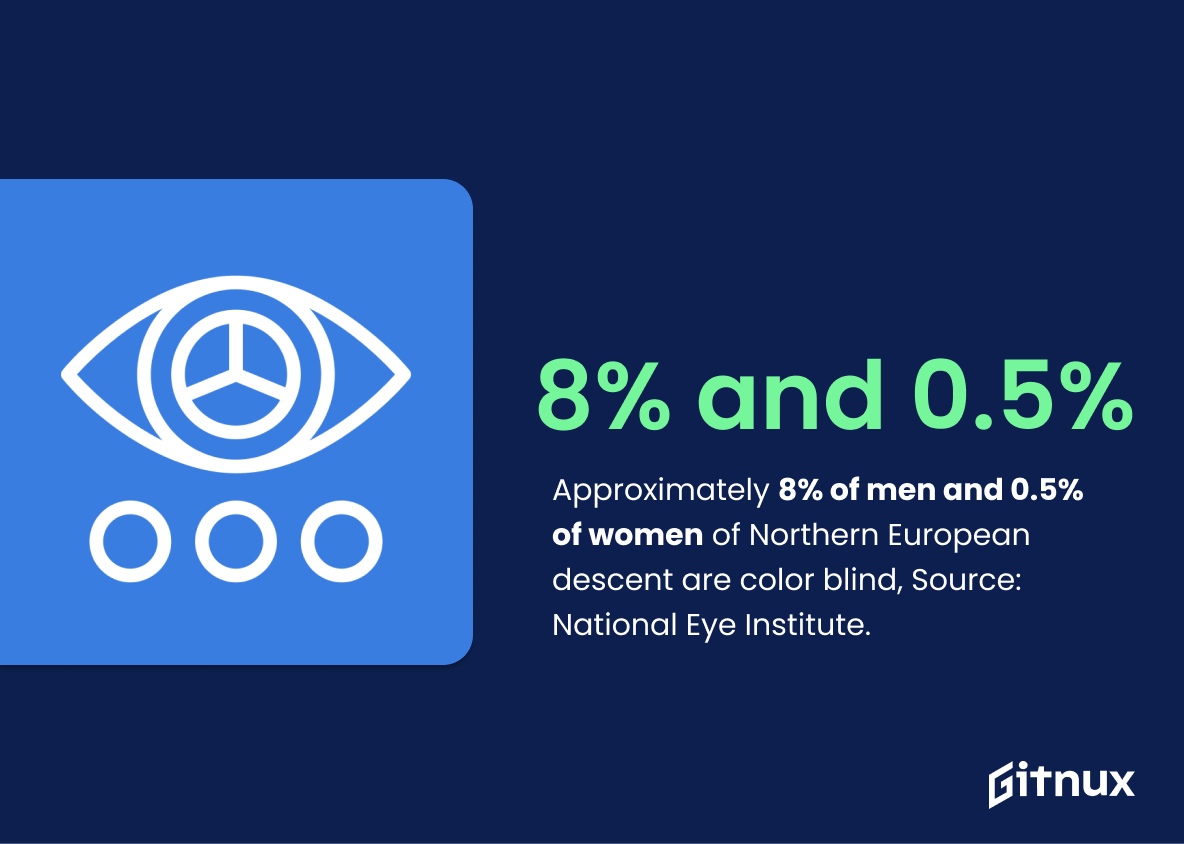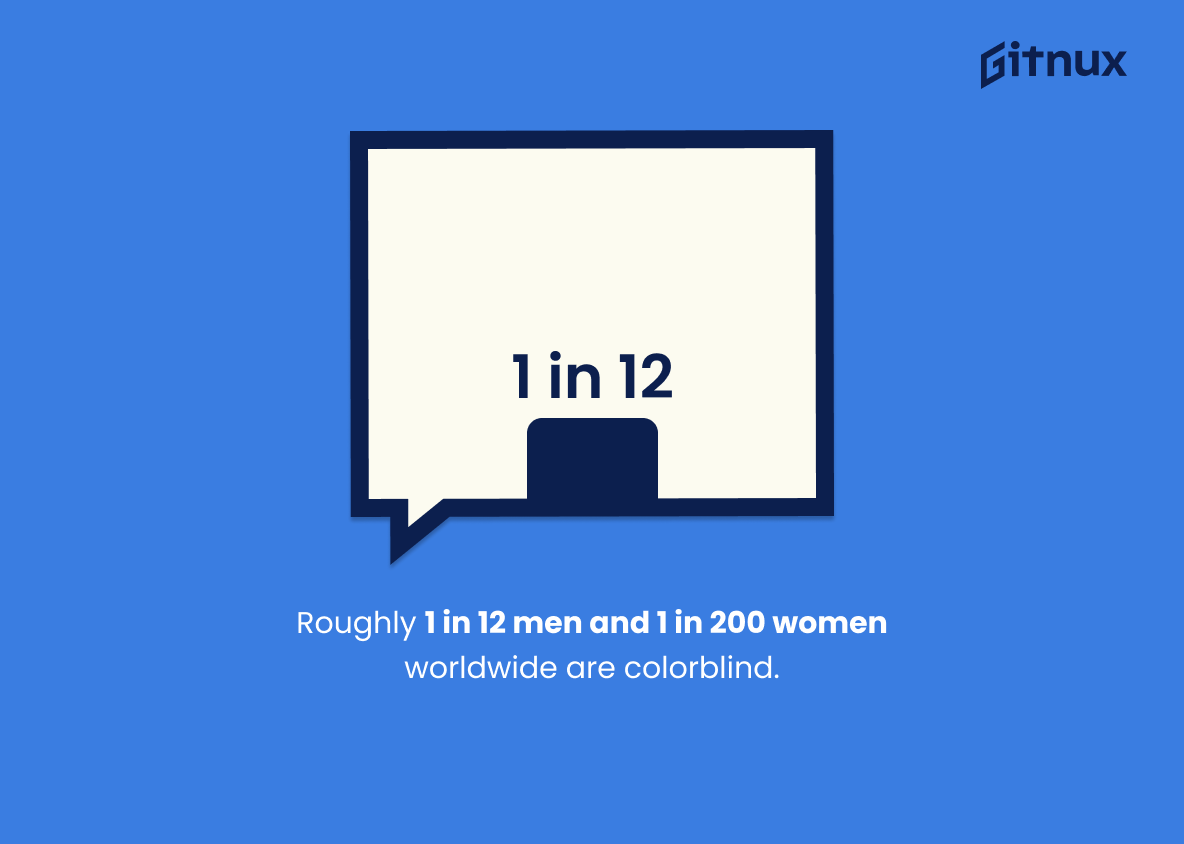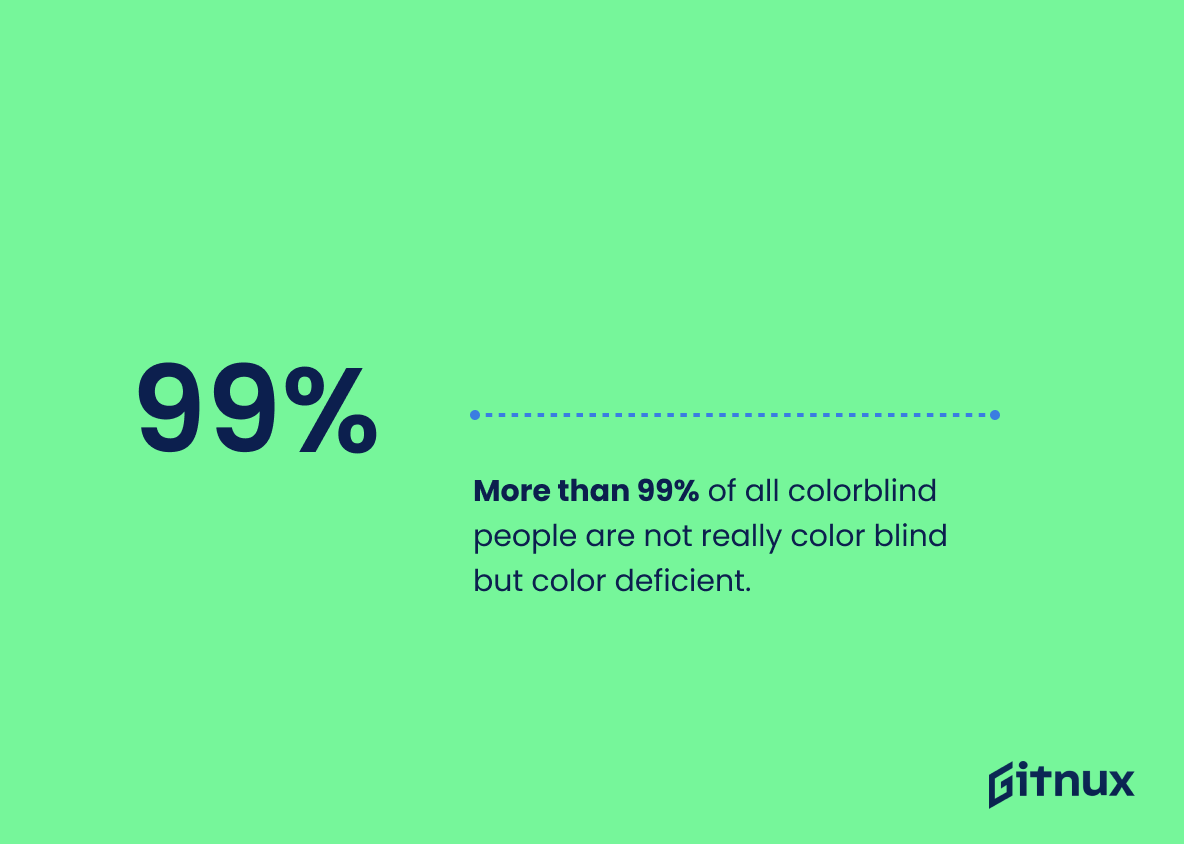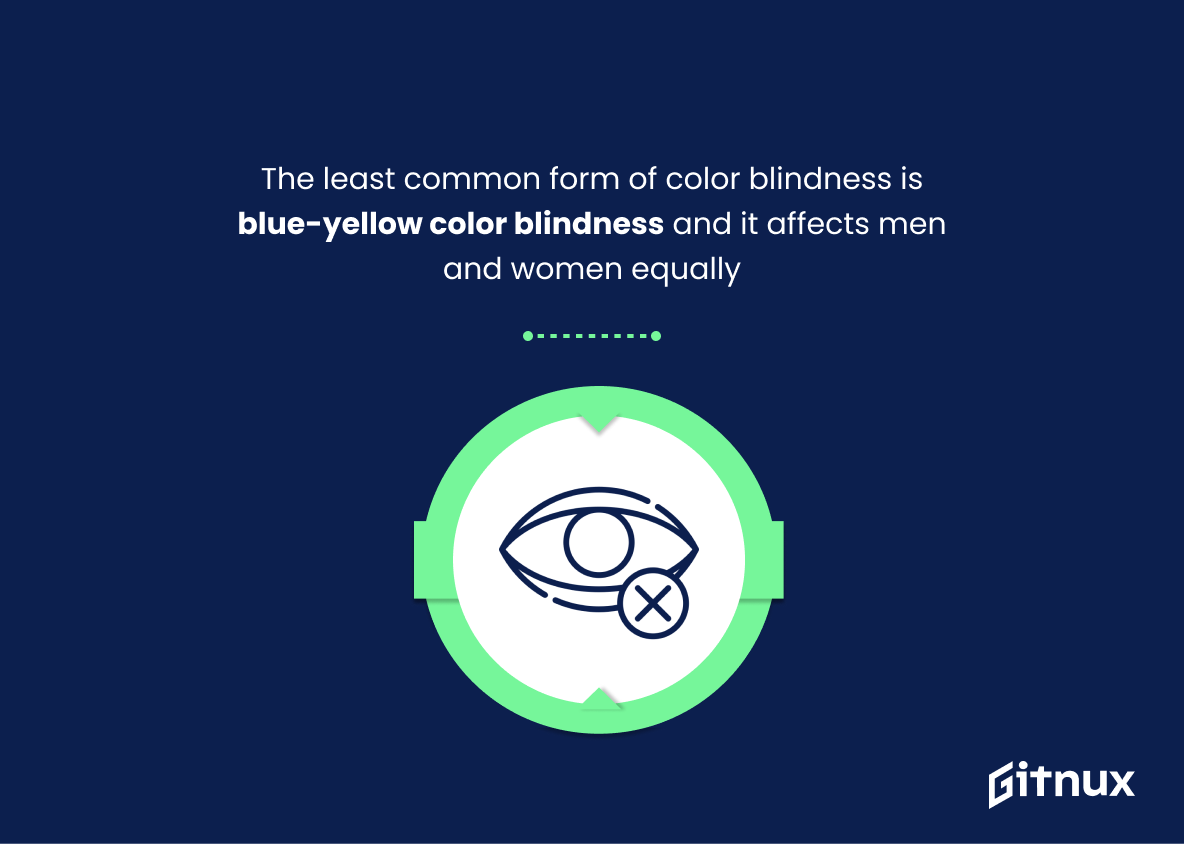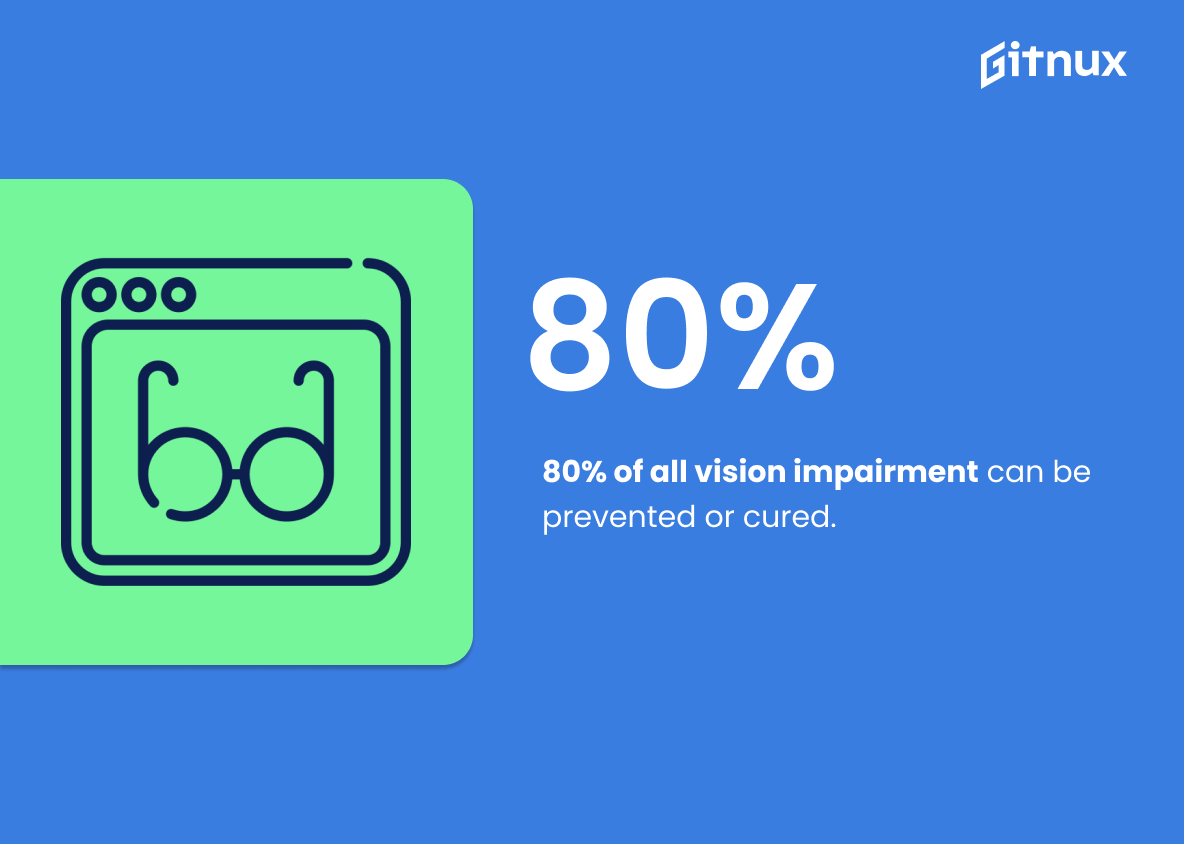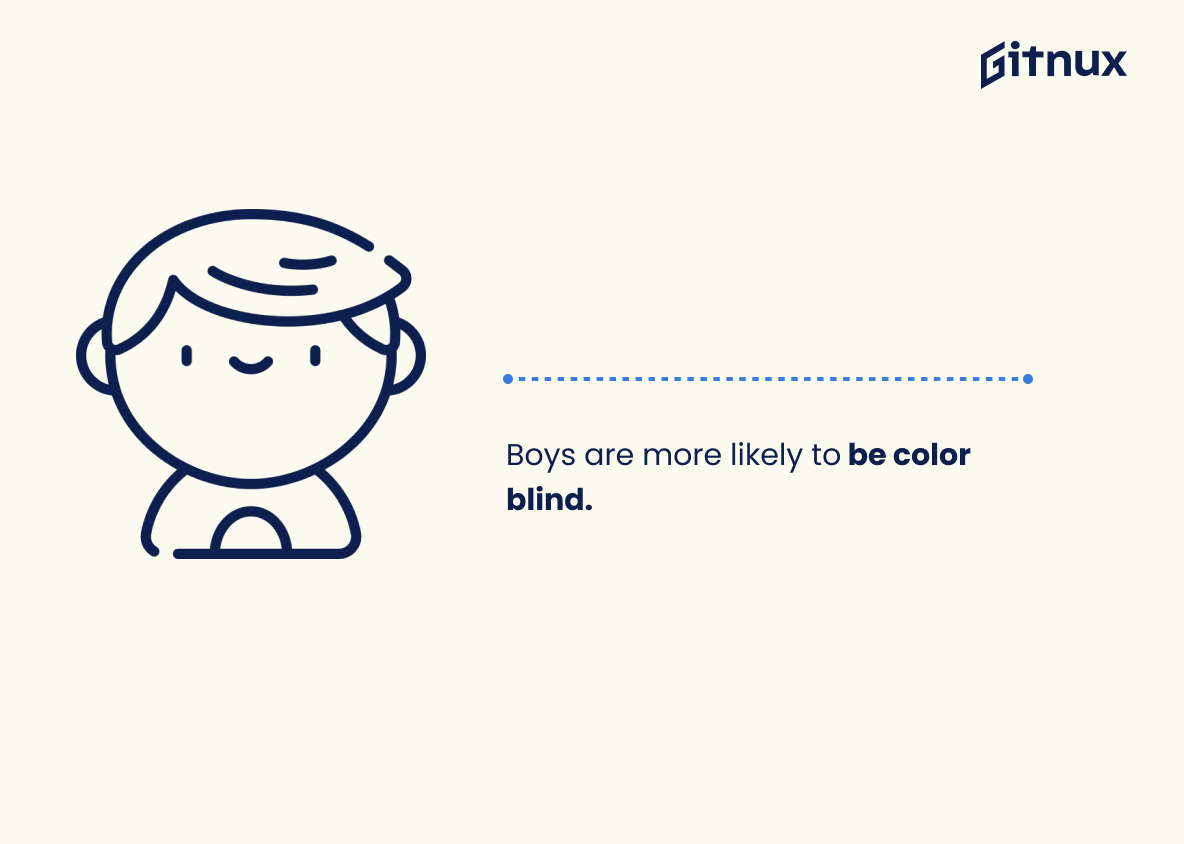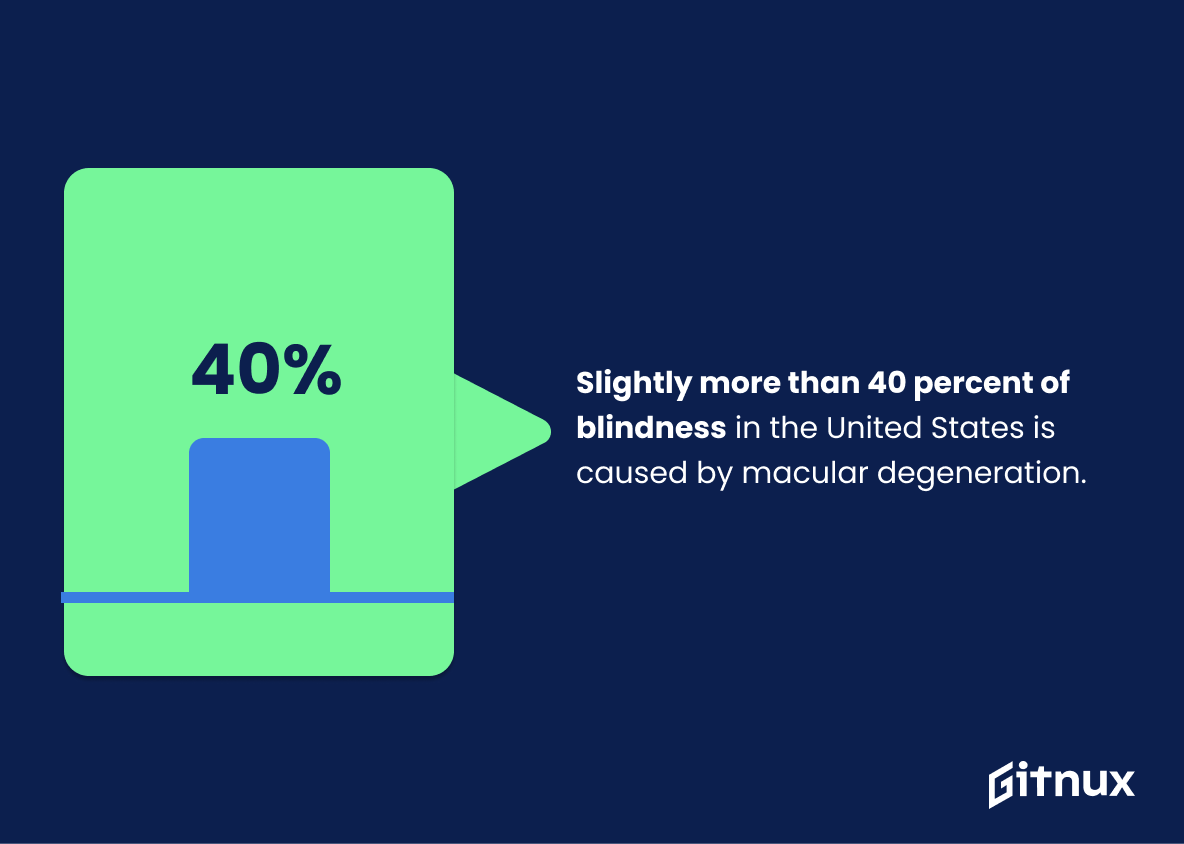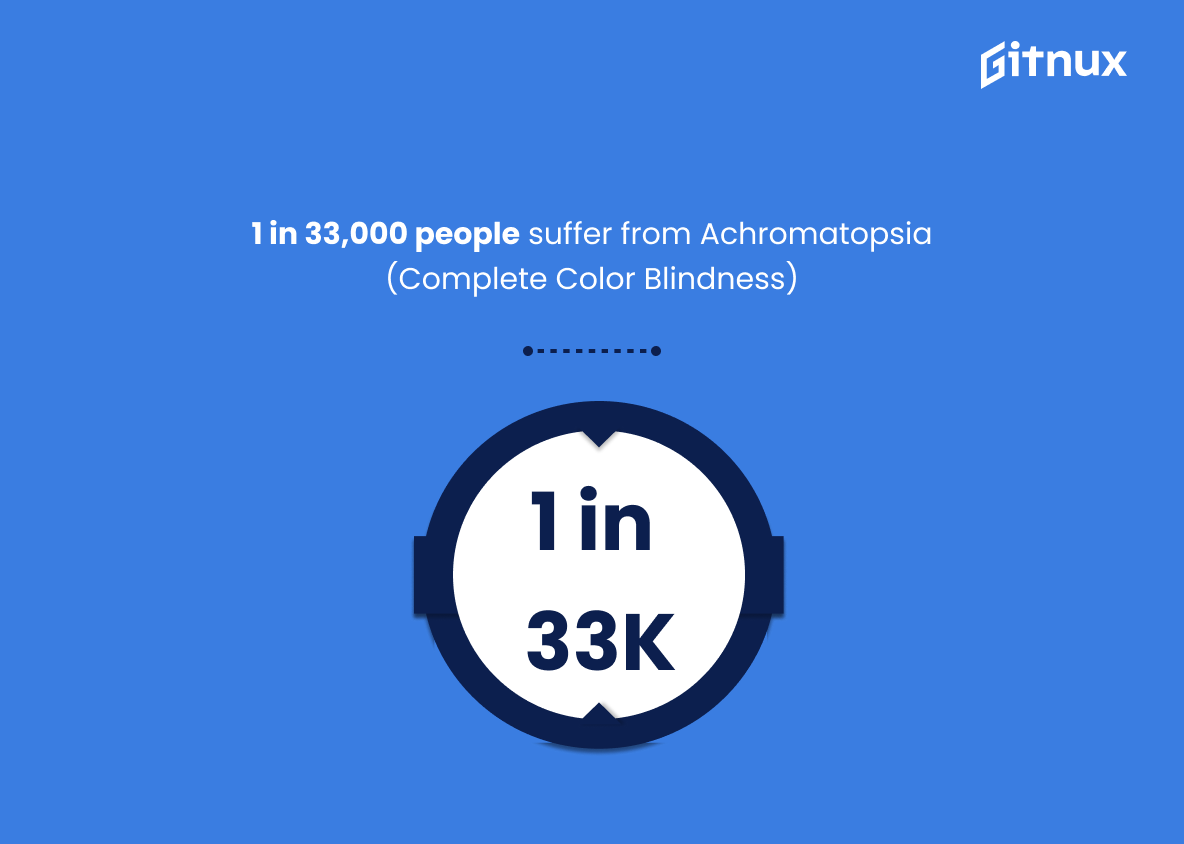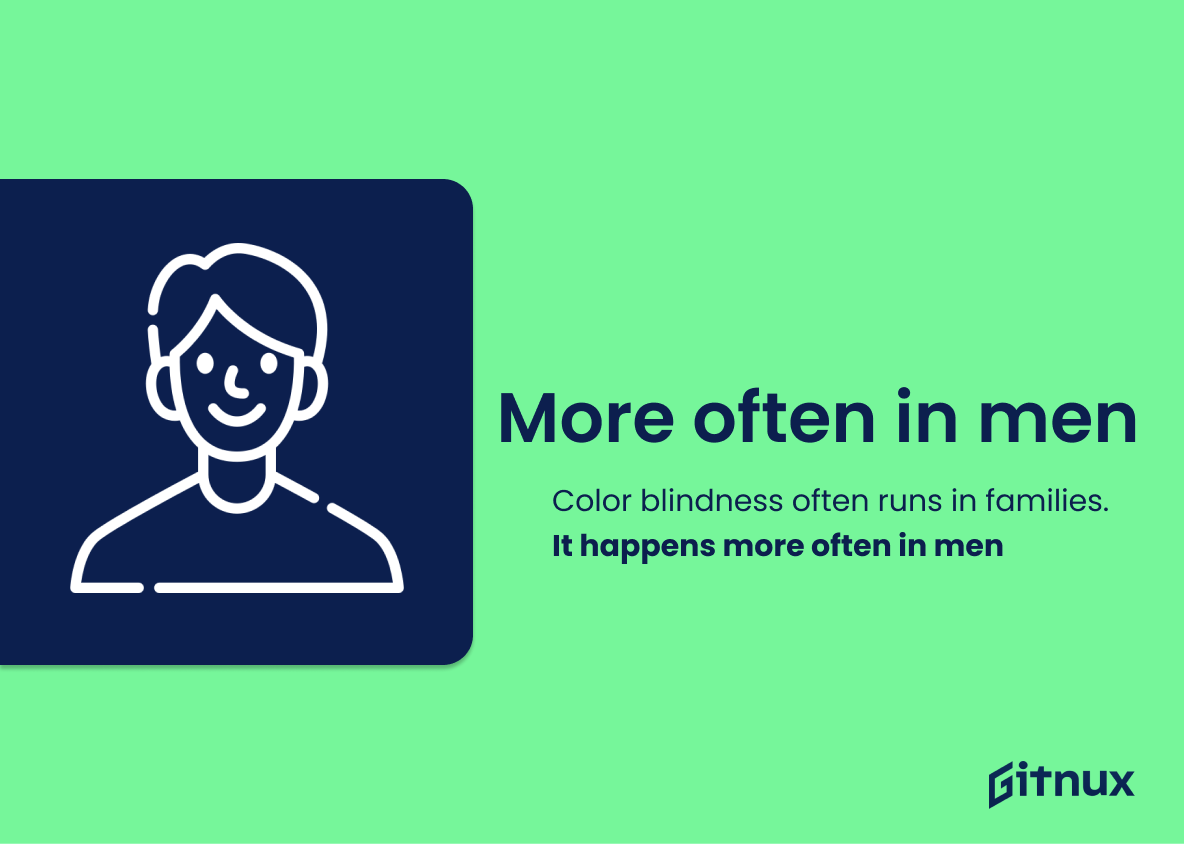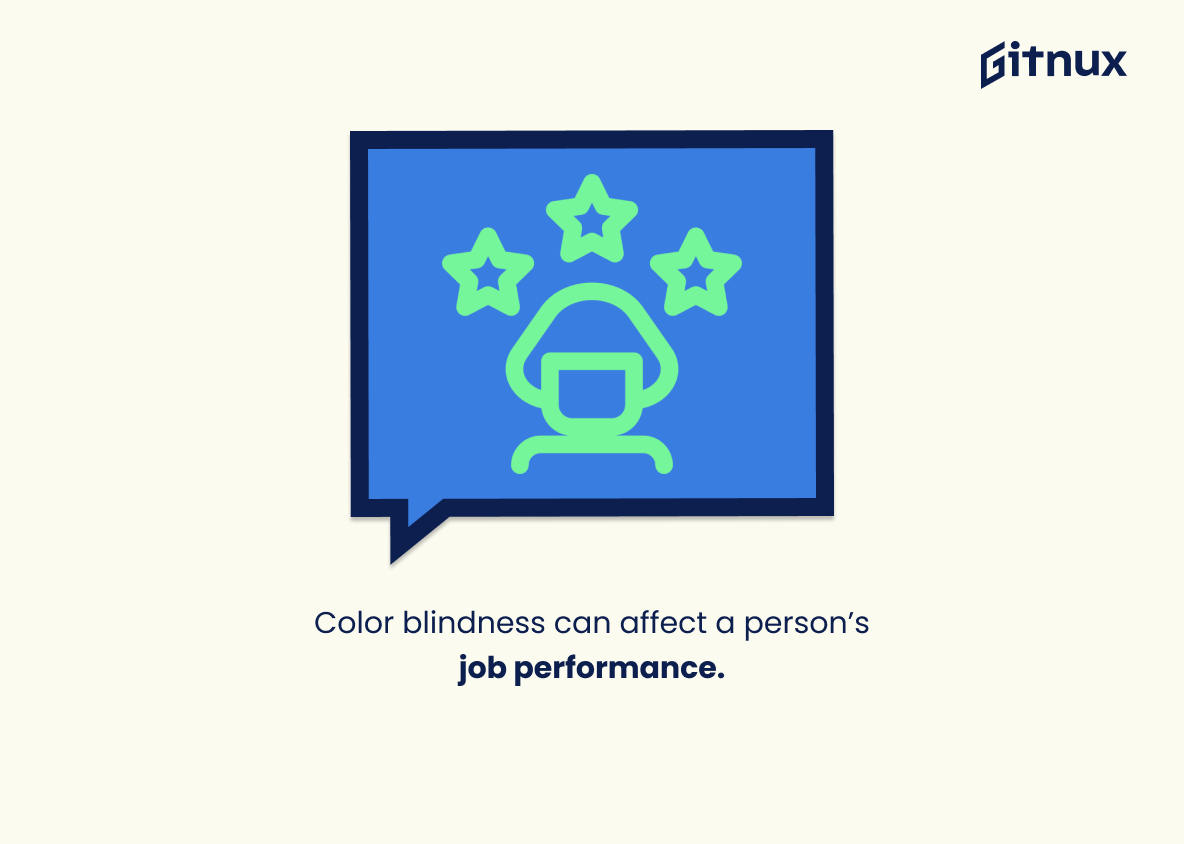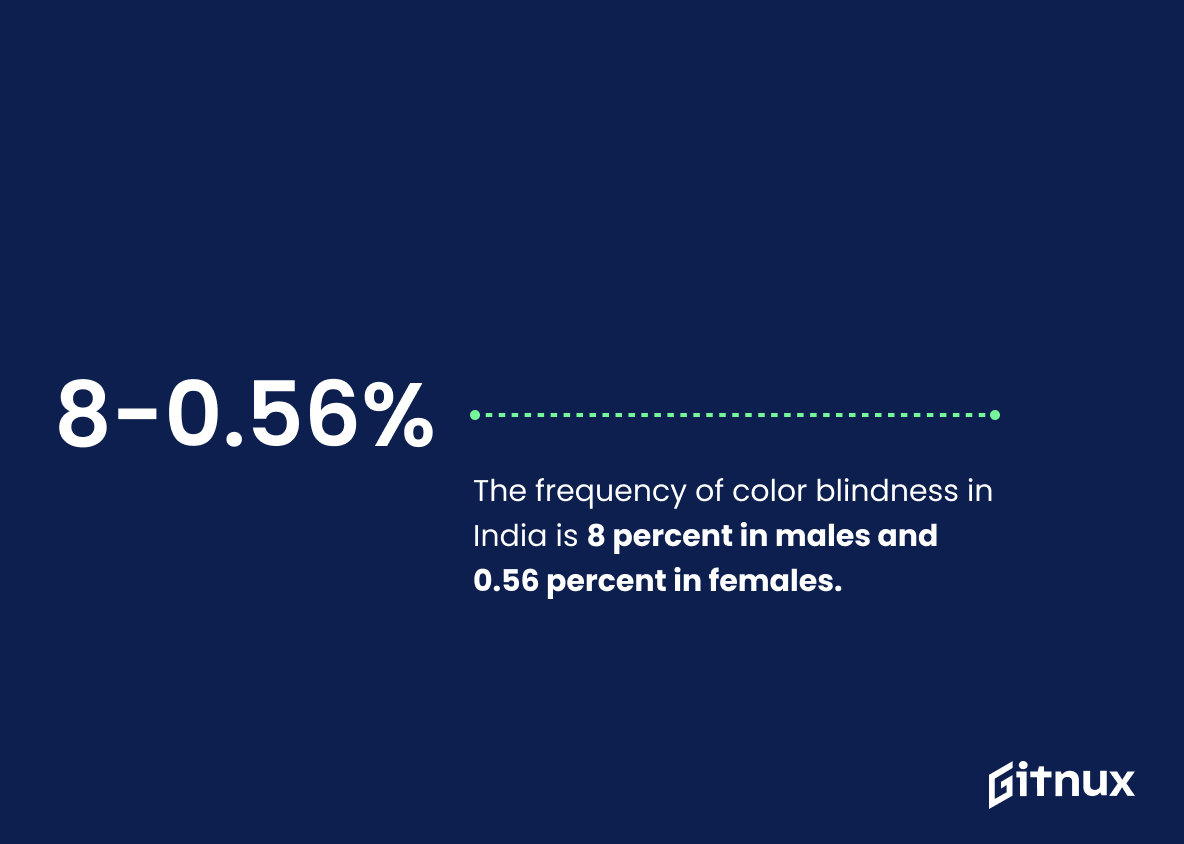In the kaleidoscopic world we live in, the explosive palette of colors shapes our perceptions and emotions. Yet, not everyone experiences these hues the way most of us do. Color blindness, a common but often misunderstood sight condition, affects a significant number of people worldwide.
This blog post delves into the fascinating world of color blindness statistics, providing a vibrant mix of facts and figures about this intriguing optical phenomenon. As we unravel the data, we’ll shed light on the various types of color blindness, how many people it affects, and how this condition influences their daily lives. Join us as we explore the technicolor tapestry of these unique visual experiences.
The Latest Color Blindness Statistics Unveiled
Approximately 8% of men and 0.5% of women of Northern European descent are color blind, Source: National Eye Institute.
Delving into statistics on color blindness like the one from the National Eye Institute, adds significant weight and context to our understanding of the subject. Expounding the disparity, we discover that color blindness is approximately 16 times more prevalent in men of Northern European descent compared to women of the same lineage.
This marked difference illuminates gender-linked genetic factors and shines a light on how color blindness predominantly affects males. In a broader discussion about color blindness, such data fosters an enriched awareness and contributes to the deeper comprehension of the variability and distribution of this condition.
Roughly 1 in 12 men and 1 in 200 women worldwide are colorblind, Source: Colour Blind Awareness.
Highlighting that approximately 1 in 12 men and 1 in 200 women globally are colorblind captures the real-world implications of this condition in a compelling way. These figures help to illustrate the fact that color blindness is not an uncommon anomaly, but an everyday reality for millions.
Engaging readers with these statistics can usher in a stronger appreciation for the challenges faced by those living with color blindness, as well as a call to action for enhanced research and development in accessible technologies. Furthermore, these numbers offer valuable insights for businesses and organizations aiming to create color-friendly environments or initiatives, be it in the digital landscape, classroom settings, workplace environments, or product designs.
More than 99% of all colorblind people are not really color blind but color deficient, Source: Colblindor.
Drawing a line between the commonly applied term ‘color blindness’ and the more accurate description ‘color deficiency’ intensifies the need for a nuanced understanding of this condition. Highlighting the fact that over 99% of individuals categorized as colorblind are actually color deficient, unravels the oversimplified popular belief, paving the way for a more accurate and empathetic discussion.
The ambiguity of this terminology may cause unnecessary bottlenecks in comprehending the challenges faced by these individuals and designing plausible solutions. This statistic, hence, lights up the path leading to a well-informed and fair perspective of color vision disorders.
The most common type of color blindness is red-green color blindness, Source: American Academy of Ophthalmology.
Diving into the rainbow-colored sea of color blindness statistics, the standout fact that red-green color blindness wears the crown as the most common type contrasts vividly. This statistic, verified by the American Academy of Ophthalmology, is like a neon sign, drawing attention to a commonly overlooked aspect of vision impairments.
It highlights the prevalence of this specific form of color blindness and thus underscores the need for further research, accessible aids, and public awareness to help those navigating life with such a condition. Subsequently, this information assists in providing a comprehensive outlook on color-blind realities, subsequently shaping the narrative and shaping paths for effective remedial actions.
The least common form of color blindness is blue-yellow color blindness and it affects men and women equally, Source: Prevent Blindness.
In the kaleidoscopic world of color blindness statistics, the nuanced insight into blue-yellow color blindness plays a pivotal role. Not only does it shine a light on the rarity of this particular form of color blindness, but it also breaks the gender bias, emphasizing a fascinating equality between men and women. Smudging the preconceived norms, the aforementioned statistics serve as a testimony to the intriguing variations in the nature of color blindness, enriching the readers’ understanding and perpetuating a more comprehensive discussion on the topic in a blog post.
80% of all vision impairment can be prevented or cured, Source: World Health Organization.
Highlighting the statistic from the World Health Organization, proclaiming that 80% of all vision impairment can be prevented or cured, adds weight to our discussion on color blindness. Parading this poignant fact in front, not only allows readers to acknowledge the partially hidden potential of modern medicine, but it also adds a glimmer of optimism to color blindness, which is often considered irreversible.
It underscores the need for continuous research and exploration in managing and potentially treating color vision deficiencies, mirroring the phenomenon in larger vision impairment issues. In the grand tapestry of our conversation about color blindness, this statistic is the vibrant thread weaving hope and possibility amidst the challenges.
Inherited color blindness is most common, but it can also occur from physical or chemical damage to the eye, the optic nerve, or parts of the brain, Source: American Optometric Association.
Delving into the roots of color blindness, this statistic offers insight and explanation, shifting our perspective from what many believe to be solely a genetic issue to recognizing environmental factors. The American Optometric Association clarifies that not only genetics, but physical or chemical damage to the eye, optic nerve, or brain can lead to color blindness. For those writing or reading about color blindness statistics, this widens the understanding of its causes, revealing the multifaceted nature of this condition, moving beyond genetics to encompass environmental triggers.
This insight also signifies the importance of eye safety and maintaining overall health, as these factors could contribute to such a condition. Hence, incorporating this statistic into a blog about color blindness adds depth to our comprehension and highlights the necessity for a broader perspective when addressing and discussing such conditions.
Boys are more likely to be color blind, Source: Stanford Children’s Health.
Highlighting this statistic assists in underlining the gender disparity that prevails in color blindness prevalence, with boys demonstrating a higher susceptibility. Stanford Children’s Health, a reliable source offering this statistic, reinforces our understanding of the genetic makeup behind color blindness. In the realm of color-blindness statistics, presenting such data serves as a beacon, illuminating potential health concerns for boys, whether in educational, home, or social settings.
Slightly more than 40 percent of blindness in the United States is caused by macular degeneration, Source: BrightFocus Foundation.
Dipping our toes into the expansive ocean of color blindness statistics, a significant wave arises when we consider that slightly more than 40 percent of blindness in the United States is attributed to macular degeneration, according to BrightFocus Foundation data. This statistic is a crucial puzzle piece when sketching out the full picture of understanding visual impairments.
It places in sharp relief the prominence of macular degeneration within the labyrinth of sight disorders, offering valuable insights to readers seeking comprehensive knowledge. Most importantly, given the marked impact on an individual’s ability to differentiate colors, it predicates the importance of early detection and further exploration of treatment methods. Painted with this statistic, the blog post gains depth, becoming a more nuanced platform for promoting essential conversation on vision health.
1 in 33,000 people suffer from Achromatopsia (Complete Color Blindness), Source: National Organization for Rare Disorders.
Peering into the kaleidoscope of color blindness realities, let’s spotlight the relatively unknown statistic of 1 in 33,000. Achromatopsia, also known as a Complete Color Blindness, impacts this sliver of the population, as reported by the National Organization for Rare Disorders. This statistic injects perspective into our conversation on color blindness; it quantifies the rarity of total color blindness in contrast to more common forms of color vision deficiency.
When we discuss color blindness, mostly it’s the red-green color imperfection that dominates the conversation; yet, the number reminds us of the undercurrents beneath the broader color blindness narrative. Infusing our blog post with such figures lends it a depth and richness, challenging readers to acknowledge and understand the spectrum of experiences within the colorblind community.
Color blindness often runs in families. It happens more often in men, Source: WebMD.
WebMD’s observation that color blindness is frequently inherited and is more common in men significantly enlightens the blog post on Color Blindness Statistics. Incorporating this information forms a critical piece of the puzzle, painting a broader image of the condition’s genetic predisposition, as well as its disproportionate impact on males.
It serves as an anchor, grounding readers in the reality of color blindness— knowledge that could inspire heightened awareness, encourage genetic counseling, or even drive advancements—making it a cornerstone statistic on the topic.
Color blindness can affect a person’s job performance, Source: American Academy of Ophthalmology.
Illuminating the significance of this intriguing statistic, we delve into the profound implications it carries in the grand scheme of life. The American Academy of Ophthalmology serves as the guiding light in stating how color blindness can influence an individual’s job performance. This insight underscores a profound and often overlooked aspect of color blindness. It brings our attention to its not-so-obvious repercussions that extend beyond mere difficulty in distinguishing colors, impacting everyday activities, especially the job performance of the affected.
An in-depth understanding of this statistic can potentially help employers create more inclusive work environments, encourage innovations in adaptive technologies, and stimulate policies that accommodate the unique needs of those living with color blindness. Indeed, this statistic unfolds much more than just numbers; it unveils a world enacted in diverse hues of everyday experiences.
The frequency of color blindness in India is 8 percent in males and 0.56 percent in females, Source: Springer Link.
In crafting a blog post centered around Color Blindness Statistics, the provided data point becomes a vibrant centerpiece. It illuminates the contrasting prevalence rates of color blindness among males and females in India. This clear discrepancy underlines the notion that genetic factors can significantly influence the occurrence of color blindness, as it is largely agreed that males are more prone to inherit this condition due to X-linked inheritance pattern.
Including this statistic not only enriches our understanding of the condition’s distribution but also lays a roadmap for exploring the connections between genetics, gender, and color blindness. Moreover, it invites much-needed focus on India, a country whose expansive population offers highly significant data for the study.
Conclusion
Understanding color blindness statistics can be key to enhancing inclusivity and accessibility across different fields, from website design to public infrastructure planning. The prevalence of color blindness assures us this isn’t a negligible issue.
While it’s not curable, simple adaptions can significantly improve the everyday lives of color blind individuals. As we strive towards a more inclusive society, it’s essential for all of us to educate ourselves about color blindness and take affirmative actions to accommodate these differences. Remember, color blindness isn’t a hindrance; it’s just a different way of perceiving the vibrant world around us.
References
0. – https://www.rarediseases.org
1. – https://www.link.springer.com
2. – https://www.www.brightfocus.org
3. – https://www.www.colourblindawareness.org
4. – https://www.www.color-blindness.com
5. – https://www.www.preventblindness.org
6. – https://www.www.aao.org
7. – https://www.www.aoa.org
8. – https://www.www.nei.nih.gov
9. – https://www.www.webmd.com
10. – https://www.www.who.int
11. – https://www.www.stanfordchildrens.org
